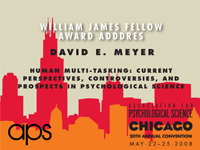Investigating Interracial Interactions
The last several decades have seen large declines in racial bias in social institutions in the United States. While far from perfect, barriers have been substantially decreased in education, business, politics, and communities. Yet, at the individual social level, interracial interactions can still be stressful. Jennifer Richeson, Northwestern University, has explored the psychological processes involved in this dichotomy. She presented her recent findings in the presentation “Negotiating Interracial Interactions: Costs, Consequences and Possibilities” at the APS 20th Annual Convention.
During an encounter between people of different races, if one or both parties are worried about the possibility of expressing or being thought to express prejudice, they may experience some level of anxiety or self-consciousness and may even induce physiological responses to stress, like an increased heart rate and constriction of blood vessels. These reactions can also be cognitively costly. After being primed with a racial situation, like discussing racial profiling with someone of a different race, study participants perform worse on the classic Stroop task. And those with higher bias perform even more poorly. Richeson believes that because they are aware of possible bias and dealing with physiological arousal, individuals must actively self-regulate during interracial interactions. This self-regulation uses cognitive resources and leads to depletion in other areas.
Richeson conducted two further studies to investigate these interactions. In the first, white participants were brought into the lab, given a race Implicit Association Test (IAT — the now standard test of underlying bias), videotaped by either a black or white experimenter while talking about controversial topics, and then given a Stroop task. Two weeks later, these participants were called for what they believed was an unrelated fMRI study. In the fMRI study, participants were presented with pictures of black and white faces in various locations on a screen and asked to press a button corresponding to where the picture appeared on the screen. The fMRI study found that the dorsolateral prefrontal cortex (DLPFC) and anterior cingulate cortex (ACC), both regions of the brain that are thought to control executive function, tended to be more activated when participants were looking at black faces. What’s more, this finding matches the findings of the IAT and Stroop task impairment. Of these all-white participants, those with higher implicit bias were more likely to have activity in the DLPFC when looking at black faces, and those with higher neural activity when looking at black faces had more Stoop Task impairment after interracial contact.
In order to investigate what occurs in actual interactions, Richeson and collaborator Nicole Shelton, Princeton University, recruited black and white participants to take a race IAT and then engage in a 10-minute conversation about racial issues. White participants engaged in a conversation with another white participant or with a black participant. In same-race interactions, those with higher bias IAT scores were rated lower by their counterparts on likability. But, ironically, in interracial interactions, black participants liked higher-biased white participants more than lower-biased white participants and found them to be more engaged in the interaction. It seems that higher-biased individuals are aware that they could seem biased and so they self-regulate and in a sense turn on the charm to ensure that the interaction goes smoothly.
So, as Richeson said, the “intra-personal costs may come with inter-personal benefits.” Although it may seem like a positive thing that interracial interactions appear to go well, even when bias is involved, it should not overshadow the fact that interracial interaction is cognitively and physiologically draining. This could cause individuals, especially in those who are most biased, to avoid interracial interactions when possible, a situation which leads to less interracial interaction and undermines the interracial ideals to which our society aspires.




APS regularly opens certain online articles for discussion on our website. Effective February 2021, you must be a logged-in APS member to post comments. By posting a comment, you agree to our Community Guidelines and the display of your profile information, including your name and affiliation. Any opinions, findings, conclusions, or recommendations present in article comments are those of the writers and do not necessarily reflect the views of APS or the article’s author. For more information, please see our Community Guidelines.
Please login with your APS account to comment.